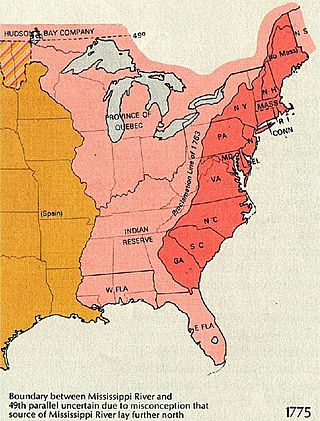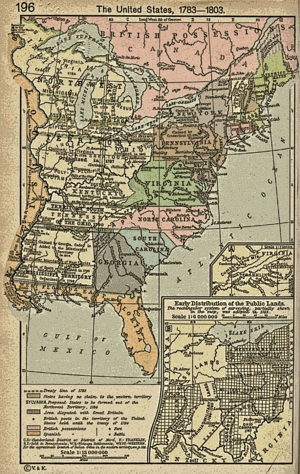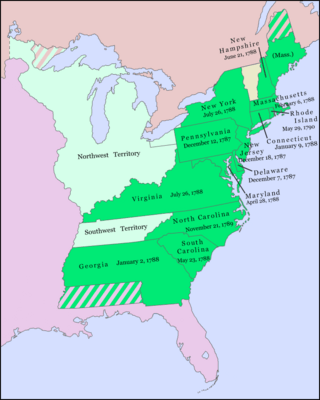History of the United States (1776–1789) facts for kids
Quick facts for kids 1776–1789 |
|
| Preceded by | Colonial Period |
|---|---|
| Including | American Revolution Confederation Period Second Great Awakening |
| Followed by | History of the United States (1789–1849), Federalist Era |
Between 1776 and 1789, thirteen British colonies in America became a new, independent country: the United States of America. The American Revolutionary War began in 1775 between colonial fighters and the British Army. On July 4, 1776, the Second Continental Congress declared independence with the Declaration of Independence. General George Washington led the Continental Army and Navy to defeat the British. This secured freedom for the thirteen colonies. In 1789, the 13 states replaced the Articles of Confederation (from 1777) with the U.S. Constitution. This Constitution, with its changes, is still the main law of the United States today.
Contents
How the Revolution Started
For many years, the British government mostly left its American colonies alone. This was called "salutary neglect." Because of this, the colonies learned to govern themselves. About half of the white men in America could vote, compared to only one percent in Britain. The colonies developed their own political ideas. They believed in a republican way of thinking. This meant they did not want kings or nobles. They wanted the people to have power and to do their civic duty.
In 1763, Britain won the French and Indian War. After this, Britain started to pay more attention to the colonies. They began to tax the Americans, starting with the Stamp Act of 1765. Americans felt these taxes were unfair because they had no representatives in the British Parliament. Parliament argued that Americans were "virtually" represented.
Arguments with London grew worse after 1765. By 1772, colonists started to create their own local governments. They formed "committees of correspondence" to organize protests. In 1774, they held the First Continental Congress. Here, they decided to stop trading with Britain. Twelve colonies sent representatives. Georgia did not attend because it was under strong British control.
In 1773, resistance in Boston led to the Boston Tea Party. Colonists dumped British tea into the harbor to protest taxes. In response, London passed the Intolerable Acts against Massachusetts. These laws ended self-government there and sent the British Army to take control. Patriots in Massachusetts and other colonies prepared their militias to fight.
The American Revolution: Fighting for Freedom
George Washington's Leadership in the War
General Washington played five key roles during the war.
First, he planned the overall war strategy with Congress. The main goal was always independence. When France joined the war, Washington worked closely with French soldiers. Their help was very important for the big victory at Yorktown in 1781. Their support helped America win the war.
Second, he led troops against the main British forces from 1775 to 1777 and again in 1781. He lost many battles. However, he never surrendered his army. He kept fighting the British until the war ended. Washington also created a successful spy system. In 1778, he formed the Culper Ring to spy on British movements in New York City. In 1780, this group discovered that Benedict Arnold was a traitor.
Third, he chose and guided the generals. Congress appointed some generals, sometimes without Washington's input. State governments appointed lower-ranking officers. Some of Washington's favorite generals did not do well. But he found strong leaders like Nathanael Greene, Daniel Morgan, Henry Knox (artillery chief), and Alexander Hamilton (chief of staff). American officers often lost direct battles. But they won big victories at Boston (1776), Saratoga (1777), and Yorktown (1781). These wins came from trapping British armies with many more American troops.
Fourth, he was in charge of training the army and getting supplies. This included food, gunpowder, and tents. He recruited regular soldiers. He assigned Baron Friedrich Wilhelm von Steuben, a skilled Prussian officer, to train them. Steuben turned Washington's army into a disciplined and effective fighting force. Congress was responsible for supplies. Washington pushed Congress to provide what the troops needed, but there was never enough.
Washington's fifth and most important role was being the symbol of armed resistance. His long-term plan was to always keep an army fighting. This plan eventually worked. His great personal standing and political skills kept Congress, the army, the French, militias, and states working together. He also set an important example. When the war was won, he gave up his military power and disbanded his army. He did not try to become a king. This showed that civilian leaders were in charge of the military.
When the Fighting Began
On April 19, 1775, the British military governor sent troops to take gunpowder and arrest local leaders in Concord. At Lexington, Massachusetts, shots were fired with the local militia. Eight colonists died. The British did not find their targets in Concord. As they went back to Boston, about 3,800 militia members attacked them. This was the Battle of Lexington and Concord, and it started the American Revolutionary War.
As news spread, local "committees of correspondence" in the 13 colonies drove out British officials. They sent militiamen to Boston to surround the British army there.
The Second Continental Congress met in Philadelphia, Pennsylvania, after the April clashes. All thirteen colonies were represented. They immediately began to act as a central government. They took control of diplomacy and told the colonies to write their own state constitutions. In June 1775, George Washington, a respected leader from Virginia with military experience, was chosen to lead the new Continental Army. He took command in Boston and asked for cannons to attack the British.
In every state, a small number of people stayed loyal to the King. These Loyalists had no power. Local "Committees of Safety" watched them closely. Loyalists could stay silent. But if they openly supported the King with words, money, or military help, it was not allowed. The property of outspoken Loyalists was taken. Many fled to British-controlled areas, especially New York City.
Attempt to Invade Canada
In the winter of 1775–76, American Patriots tried to capture Quebec but failed. British forces grew stronger in Halifax, Nova Scotia. This stopped Nova Scotia from joining the 13 colonies. The Americans did manage to capture a British fort at Ticonderoga, New York. They dragged its cannons through the snow to Boston. When these cannons appeared on Dorchester Heights outside Boston, the British Army left the city on March 17, 1776.
Debating Independence
During the talks about the Declaration of Independence, Thomas Jefferson wanted to include a part that criticized King George III. It would have blamed the King for "waging cruel war against human nature itself" by allowing the slave trade. He called it an "execrable Commerce" and slavery a "cruel war against human nature."
Southern states demanded that this part be removed. They said they would only join the revolution if it was taken out. Jefferson had no choice but to remove it.
Declaring Independence
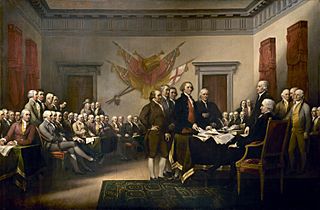
On July 2, 1776, the Second Continental Congress, still in Philadelphia, voted to declare independence. They called themselves the "United States of America." Two days later, on July 4, Congress approved the Declaration of Independence.
A group called the Committee of Five wrote the Declaration. This group included John Adams, Thomas Jefferson, Roger Sherman, Robert Livingston, and Benjamin Franklin. Jefferson wrote the first draft, and others revised it. The Declaration stated that "all men are created equal" with "certain unalienable rights." These rights include "life, liberty, and the pursuit of happiness." It also said that governments get their power from the "consent of the governed." The Declaration also listed the colonists' main complaints against the King. Since then, July 4 has been celebrated as the birthday of the United States.
The men who signed the Declaration were important Patriot leaders. Most were educated, lived in older settlements, and were from a well-off class. They were mostly of British background and Protestant faith.
Battles of 1776 and 1777
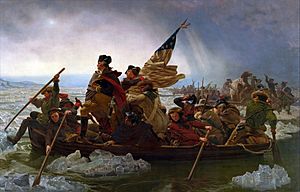
The British returned with a large force in August 1776. They landed in New York and defeated the new Continental Army at the Battle of Long Island. This was one of the war's biggest battles. The British quickly took New York City and almost captured General Washington and his army. New York City became their main base in North America until 1783. Many Loyalists moved there. The city also became a key spot for Washington's spy network.
The British soon took New Jersey. American hopes seemed low. Thomas Paine wrote, "these are the times that try men's souls." But Washington fought back with a surprise attack. He crossed the icy Delaware River into New Jersey. He defeated British armies at Trenton and Princeton. These victories helped America regain New Jersey. The wins greatly boosted Patriot morale and became famous moments of the war.
In early 1777, Britain planned a major strategy called the Saratoga campaign. Two British armies were supposed to meet in Albany, New York. This would divide the colonies and separate New England from the rest. But bad communication and planning caused problems. The army coming from Canada, led by General John Burgoyne, got stuck in thick forests north of Albany. Meanwhile, the other British army that was supposed to go up the Hudson River went to Philadelphia instead. They hoped to end the war by capturing the American capital.
Burgoyne's army was defeated at Saratoga by many local militia, led by American regulars. This battle showed the British that Americans were strong and determined fighters. One British officer said they were "not that contemptible enemy we had hitherto imagined them."
The American victory at Saratoga led France to openly join the war as a military ally. This was through the Treaty of Alliance (1778). Spain and the Netherlands, both strong naval powers, soon joined France. They wanted to weaken British power. Britain now faced a major European war. The French navy ended Britain's control of the seas. Britain had no allies and faced the threat of invasion across the English Channel.
The British Move South, 1778–1783
The British controlled most northern coastal cities, while Patriots held the countryside. So, the British tried to win the war by attacking the southern states. They had few regular troops. British commanders knew they needed many Loyalists to join them.
In late December 1778, the British captured Savannah. In 1780, they launched a new attack and took Charleston. A big victory at the Battle of Camden meant the British soon controlled most of Georgia and South Carolina. The British built forts inland, hoping Loyalists would join them. But not enough Loyalists showed up. The British had to move out. They fought their way north into North Carolina and Virginia with a much weaker army. Behind them, much of the land they left turned into a chaotic guerrilla war. Patriot groups slowly defeated the Loyalist groups.
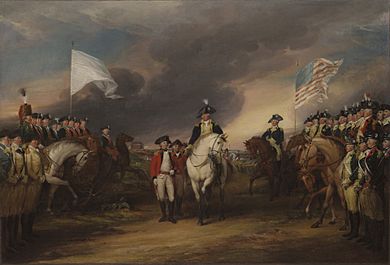
The British army, led by Lord Cornwallis, marched to Yorktown, Virginia. They expected a British fleet to rescue them. But a French fleet defeated the British fleet in the Battle of the Chesapeake. Cornwallis's army was trapped. They were surrounded by a much larger force of Americans and French, led by Washington. On October 19, 1781, Cornwallis surrendered.
News of this defeat effectively ended the fighting in America. However, the naval war continued. Support for the war had never been strong in Britain. Many British people sympathized with the American rebels. Now, support reached a new low. King George III wanted to keep fighting. But he lost control of Parliament and had to agree to peace talks.
States Begin to End Slavery
While the war was ending, the northern colonies started making plans to abolish slavery. This was despite the South's disagreement. By 1780, Pennsylvania and Massachusetts had already ended slavery.
Pennsylvania passed "An Act for the Gradual Abolition of Slavery." This was the first time in history that a democracy abolished slavery. Massachusetts legally abolished it, but did not enforce its laws against slavery until 1783. A ruling by the Massachusetts Supreme Court, known as "the Quock Walker case," made it effective.
Peace and Remembering the Revolution
Long talks led to the Treaty of Paris (1783). This treaty gave very good borders to the United States. It included almost all land east of the Mississippi River and south of Canada. The only exception was British West Florida, which went to Spain. This huge area was almost as big as Western Europe. It had a few thousand American pioneers and tens of thousands of Native Americans. Most Native Americans had been allies of the British but were now left behind by London.
Every country remembers its founding. Later generations use these memories to build their identity and patriotism. The memory of the Revolution has often been used in politics. For example, the "Tea Party movement" in the 21st century specifically remembered the Boston Tea Party as a protest against too much government.
The Patriots relied on Catholic France for military, money, and diplomatic help. This caused a sharp drop in anti-Catholic feelings. The King, not the Pope, became the enemy for Patriots. Anti-Catholicism remained strong among Loyalists. Some went to Canada after the war, but 80% stayed in the new nation. By the 1780s, Catholics were given legal tolerance in all New England states that had been hostile before. "In the midst of war and crisis, New Englanders gave up not only their loyalty to Britain but one of their most dearly held prejudices."
Historians say the Revolution is the main source of "American civil religion." This is a way of thinking that has shaped patriotism and the meaning of the nation's birth ever since. Key events and people were seen as symbols of important virtues. The Revolution gave America a leader like Moses (George Washington), prophets (Thomas Jefferson, Thomas Paine), followers (Alexander Hamilton, James Madison), and martyrs (Boston Massacre, Nathan Hale). There are also sacred places (Valley Forge, Bunker Hill), rituals (Boston Tea Party), symbols (the new flag), sacred days (Independence Day), and sacred writings (The Declaration of Independence, the Constitution, and the Bill of Rights).
The Confederation Period: 1783–1789
During the 1780s, the United States was a loose group of 13 states. It faced many problems both at home and with other countries. The states had small trade wars with each other. They also struggled to stop uprisings like Shays' Rebellion in Massachusetts. The national treasury was empty, and there was no way to pay war debts. There was no national leader. Some historians describe this as a difficult time. However, others say it was also a time of economic growth and political development.
Despite the war's difficulties, the new states made great achievements. In 1784, Connecticut and Rhode Island abolished slavery. They became the 3rd and 4th states to move away from British laws regarding slavery.
In 1787, the Northwest Ordinance became law. On August 7, 1789, President George Washington signed the Northwest Ordinance of 1789 into law. This happened after the new U.S. Congress approved it with small changes under the Constitution. The Ordinance banned slavery in the Northwest Territory. It set up a government for the area. It also explained how new states could join the Union. It guaranteed that new states would have the same rights as the original 13 states. These states, created from lands northwest of the Ohio River, include Ohio, Indiana, Illinois, Michigan, Wisconsin, and Iowa.
The Articles of Confederation
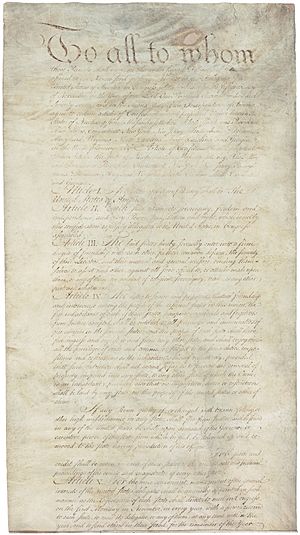
The Treaty of Paris made the United States independent and peaceful. But its government structure was not settled. The Second Continental Congress had written the Articles of Confederation and Perpetual Union on November 15, 1777. These Articles created a permanent confederation. However, they gave Congress—the only federal body—little power. It could not easily raise money or make sure its decisions were followed. There was no president and no national court system.
Historians generally agree the Articles were too weak to hold the growing nation together. But they do credit Congress for solving a big problem: states arguing over western lands. The states willingly gave their lands to national control. The Land Ordinance of 1785 and Northwest Ordinance created territorial governments. They set rules for new states to join. They divided land into useful units and set aside land in each town for public use. This system was very different from European colonization. It provided the basis for America's expansion across the continent in the 1800s.
By 1783, after the British blockade ended, the new nation began to regain its wealth. However, trade was limited by the "mercantilist" policies of European powers. Before the war, Americans shipped goods to British colonies in the Caribbean. But now these ports were closed. Only British ships could trade there. France and Spain had similar rules for their empires. They limited imports of New England fish and Chesapeake tobacco. Spain closed New Orleans, which made it hard for western farmers to ship their goods. But this did not stop many pioneers from moving west. At the same time, American businesses faced strong competition from British goods, which were suddenly available again.
Congress could not fix the currency or pay war debts. It also could not help trade between states. This made the situation worse. In 1786–87, Shays' Rebellion happened. This was an uprising of farmers in western Massachusetts against the state court system. It threatened the state government. Congress was powerless to help.
The Continental Congress could print paper money. It printed so much that its value dropped greatly. People would say "not worth a continental" for something worthless. Congress could not collect taxes. It could only ask states for money, but states did not give much. Less than $1.5 million came into the treasury between 1781 and 1784. Yet, states had been asked for $2 million in 1783 alone. In 1785, Alexander Hamilton stated that the Treasury received no taxes from New York that year.
States handled their debts differently. Most Southern states refused to pay their debts, which hurt local banks. But Virginia, North Carolina, and Georgia did well because they grew cash crops like cotton and tobacco. Maryland had financial problems and political fights. New York and Pennsylvania did well, though Pennsylvania also had political arguments. New Jersey, New Hampshire, Delaware, and Connecticut struggled. Massachusetts was in a state of near civil war and suffered from high taxes and a declining economy. Rhode Island was the only New England state that did well, mostly because it allowed pirates and smugglers.
When John Adams went to London in 1785 as the first U.S. representative, he could not get a trade treaty. Demands were made for favors, and there was no guarantee that individual states would agree to a treaty. Adams said states needed to give Congress power over trade laws. Or, states themselves needed to pass laws against Great Britain. Congress had already asked for power over trade laws but failed. Meanwhile, each state acted alone against Great Britain with little effect. When other New England states closed their ports to British ships, Connecticut quickly opened its ports to profit.
By 1787, Congress could not protect American businesses or shipping. State legislatures could not or would not stop attacks on private contracts and public credit. People who bought land expected no rise in value because the government could not defend its borders or protect its frontier people.
The idea of a meeting to change the Articles of Confederation grew popular. Alexander Hamilton realized a strong central government was needed. This would prevent foreign interference and solve problems caused by a weak Congress. Hamilton led a group of like-minded nationalists. He got Washington's support. In 1786, they held the Annapolis Convention. They asked Congress to call a constitutional convention in Philadelphia to fix the national crisis.
The Constitutional Convention
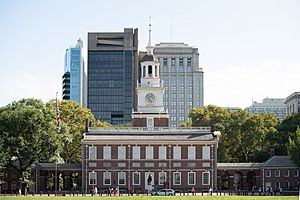
Congress, meeting in New York, asked each state to send delegates to a Constitutional Convention in Philadelphia. The goal was to amend the Articles of Confederation. But many delegates, including James Madison and George Washington, wanted to write a new constitution. The Convention started in May 1787. Delegates immediately chose Washington to lead them. Madison soon became the main force behind the Convention. He helped create the compromises needed for a strong government that all states would accept.
The Constitution proposed a federal government. It would have limited power but would be independent and superior to the states in its assigned role. It could tax and would have Executive and Judicial branches. It would also have a two-house legislature. This national legislature, or Congress, was a key compromise. Small states wanted to keep their power (one state, one vote). Large states wanted power based on their larger populations and wealth. The upper house, the Senate, would represent states equally. The House of Representatives would be elected from areas with roughly equal populations.
The Constitution itself required approval by state conventions. The Confederation Congress recommended the Constitution to the states. It asked them to call ratification conventions.
Some smaller states, led by Delaware, quickly approved the Constitution. But in the two most populated states, New York and Virginia, it became a big debate. Virginia was the first successful British colony in North America. It had a large population, and its leaders were important in the Revolution. New York was also large and populated. With the best port on the coast, it was vital for the United States' success. Local New York politics were controlled by a local elite led by Governor George Clinton. They did not want to share power with national politicians. The New York ratification convention became the center of the fight over adopting the Constitution.
Those against the new Constitution were called the Anti-Federalists. They generally preferred local power over national power. They focused on farms rather than trade or finance. They wanted strong state governments and a weak national government. They believed a strong national government would be too far from the people. It would use its powers to take over what belonged to the states.
Campaign for Approval
Those who supported the Constitution called themselves Federalists. They quickly gained support across the nation. The most important Federalists were Alexander Hamilton and James Madison. They wrote The Federalist Papers, a series of 85 essays published in New York newspapers. They used the pen name "Publius." These papers became important documents for the new United States. They are often quoted by judges. They were written to convince the New York legislature, which was closely divided.
Opponents of the stronger government plan, the Anti-Federalists, feared that a government with taxing power would become unfair and corrupt. They thought it would be like Great Britain had been just decades earlier. Notable Anti-Federalist writers included Patrick Henry and George Mason. They demanded a Bill of Rights be added to the Constitution.
The Federalists gained much respect and advantage because George Washington, who led the Constitutional Convention, approved the Constitution. Thomas Jefferson, who was serving as Minister to France at the time, had some concerns about the proposed Constitution. He decided to stay neutral in the debate and accept either outcome.
Promises of a Bill of Rights from Madison helped secure approval in Virginia. In New York, the Clintons, who controlled state politics, were outmaneuvered. Hamilton secured approval by a 30–27 vote. North Carolina and Rhode Island eventually signed on, making it unanimous among the 13 states.
The old Confederation Congress then set elections for the new Congress and the first presidential election. The electoral college unanimously chose Washington as the first President. John Adams became the first Vice President. New York was chosen as the national capital. They were sworn in during April 1789 at Federal Hall.
Under Madison's leadership, the first Congress set up all needed government agencies. They also kept the Federalist promise of a Bill of Rights. The new government at first had no political parties. Alexander Hamilton created a national network of government supporters from 1790–92. This became the Federalist Party. It controlled the national government until 1801.
However, many people still strongly supported states' rights and a limited federal government. This became the platform of a new party, the Republican or Democratic-Republican Party. It opposed the Federalists. Jefferson and Madison founded and led it. The Democratic-Republicans strongly opposed Hamilton's First Bank of the United States. American foreign policy was shaped by the start of the French Revolutionary Wars between the United Kingdom and France. Republicans supported France, seeing the French Revolution as good for democracy. The Washington administration wanted continued peace and trade with Britain. It signed the Jay Treaty, which upset Democratic-Republicans. They accused Hamilton and the Federalists of supporting aristocracy and tyranny. John Adams followed Washington as President in 1797 and continued his policies. The Jeffersonian Republicans took control of the Federal government in 1801, and the Federalists never returned to power.
Moving West
Only a few thousand Americans had settled west of the Appalachian Mountains before 1775. Settlement continued, and by 1782, 25,000 Americans lived in the Trans-Appalachian region. After the war, Americans kept settling there. Life in these new lands was hard for many. But western settlement offered the chance to own property, which was difficult for some in the East. Moving west excited even those who did not move. Many important Americans, including Washington, Benjamin Franklin, and John Jay, bought land in the west. Land speculators formed groups like the Ohio Company. They bought huge areas of land in the west and often argued with settlers. Washington and others co-founded the Potomac Company to build a canal. This canal would link the Potomac River with the Ohio River. Washington hoped this canal would connect the East and West culturally and economically. This would help ensure the West would not leave the Union.

In 1784, Virginia officially gave up its claims north of the Ohio River. Congress created a government for the region, now called the Old Northwest. This was done with the Land Ordinance of 1784 and the Land Ordinance of 1785. These laws set the rule that the Old Northwest would be governed by a territorial government under Congress. This would last until it reached a certain level of development. Then, the former territories would join the Union as states, with equal rights to other states. The federal territory covered most of the area west of Pennsylvania and north of the Ohio River. However, Connecticut kept a small part of its claim in the West. This was the Connecticut Western Reserve, a strip of land south of Lake Erie. In 1787, Congress passed the Northwest Ordinance. This gave Congress more control of the region by creating the Northwest Territory. Under this new plan, many elected officials in the territory were instead appointed by Congress. To attract Northern settlers, Congress outlawed slavery in the Northwest Territory. But it also passed a fugitive slave law to please the Southern states.
While the Old Northwest was controlled by the federal government, Georgia, North Carolina, and Virginia kept control of the Old Southwest. Each state claimed to extend west to the Mississippi River. In 1784, settlers in western North Carolina tried to become a state called State of Franklin. But Congress denied their efforts. Congress did not want to set a rule for states leaving the Union. By the 1790 Census, the populations of Tennessee and Kentucky had grown greatly to 73,000 and 35,000, respectively. Kentucky, Tennessee, and Vermont would all become states between 1791 and 1795.
With help from Britain and Spain, Native Americans resisted western settlement. Spain closed the Mississippi River in 1784. This stopped western farmers from sending their goods to the sea. This greatly hindered efforts to settle the West. The British had limited settlement of the lands beyond the Appalachians before 1776. They continued to supply weapons to Native Americans after the Treaty of Paris was signed. Between 1783 and 1787, hundreds of settlers died in small conflicts with Native Americans. These conflicts discouraged more settlement. Congress gave little military support against the Native Americans. Most of the fighting was done by the settlers. By the end of the decade, the frontier was involved in the Northwest Indian War against a group of Native American tribes. These Native Americans wanted to create an independent Indian barrier state with British support and protection. This was a major challenge for the United States' foreign policy.


